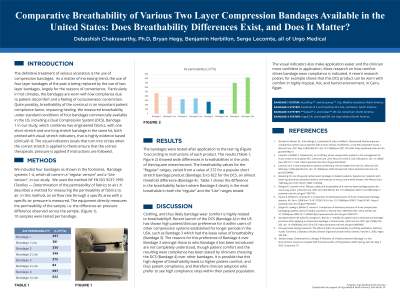Laboratory Research
(LR-009) Comparative Breathability of Various Two Layer Compression Bandages Available in the United States: Does Breathability Differences Exist, and Does It Matter?

The definitive treatment of venous ulceration is the use of compression bandages. Predominantly, the use of four layer bandages of the past are being replaced by the use of two layer bandages for the reasons of convenience. Particularly in hot climates, the bandages are worn with low compliance due to patient discomfort and a feeling of occlusiveness/constriction. Quite possibly, breathability of the construct is an important patient compliance factor, impacting healing. We measured breathability under standard conditions of four bandages commercially available in the US, including a Dual Compression System (DCS)* which combines two engineered fabrics, one with printed visual stretch indicators, that is highly evidence based (clinical).
Methods:
We included four bandages in our study. We used the method ISO 9237:1995 (Textiles — Determination of the permeability of fabrics to air). It describes a method for measuring the permeability of fabrics to air.
Results:
The bandages were tested according to instructions of each product. The results showed wide differences in breathabilities in the units liter/square meter/second. The breathability values ranged from 272 for a popular short stretch bandage product** to 822 for the DCS, an almost threefold difference.
Discussion:
Recent launch of the DCS in the US has shown high patient/clinician preference for it within users of other compression systems long established in the USA, such as the one we found possessing the least value of breathability **. The reasons for this preference are not completely understood, though patient comfort and the resulting wear compliance has been stated by clinicians choosing the DCS in favor of other more established bandages. It is possible that this high degree of breathability leads to higher patient comfort, and thus compliance, and therefore clinician adoption. The visual indicators also make application easier and the clinician more confident in application.

.jpg)